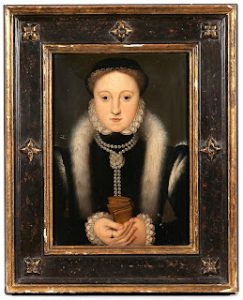Dr Stephan Edwards has studied the portraits of Lady Jane Grey and his book ‘A Queen of a New Invention: Portraits of Lady Jane Grey Dudley, England’s ‘Nine Days Queen’ was published in 2015. He also appeared as one of the talking head experts in the three part TV programme, first broadcast in 2018, ‘England’s Forgotten Queen: The Life and Death of Lady Jane Grey.’
One of ‘missing portraits’ included in his book was the Berry Hill Portrait. In November this year, the Auction Augur found the portrait listed for sale at the Butterscotch Auctioneers and Appraisers website. The portrait sold to a private buyer for $120,000.
Many thanks to Stephan for this interview about this amazing discovery.
In my interview with you in 2015, I asked ‘Are there any other ‘Jane’ portraits that you would like to analyse?’ You answered, ‘Certainly I would be keenly interested to locate and analyze any one of the ‘lost’ portraits (among them, the Berry-Hill Portrait has the greatest likelihood of actually turning up some day).’ You were right! Did you imagine it would turn up so soon?
I had no idea it would turn up so quickly, and I am thrilled that it did! But I must say, were it not for some very keen eyes and a few people already familiar with my research, it might well have remained in obscurity. We are very fortunate that Frances Mouton at the Auction Augur blog spotted the painting while covering interesting lots in upcoming auctions and had seen some of my work discussed on KatherineTheQueen.com. Others, like yourself and Lee Porritt, spotted the notice on Auction Augur and immediately contacted me, enabling me to contact the auction house. Butterscotch Auctions had accepted the painting on consignment from a family that understood it to depict Mary Stuart, popularly known today as ‘Mary, Queen of Scots,’ and had initially catalogued it under that identification. Had events not transpired as they did, it is entirely possible that the portrait could have remined identified as Mary Stuart and could have sold within the pre-auction estimate of $5000-$10,000 and disappeared again into a suburban sitting room for another half-century!
When you analysed the lost Berry Hill portrait for your book, Queen of a New Invention, was this from the black and white photograph of the portrait shown on your website? What were your first impression in seeing the high-resolution pictures posted on the Butterscotch Auction website?
Yes, while conducting the research for my book, the only photos of the Berry Hill portrait available were a very dark black and white image from 1907, the grainy black and white image published by Sir Roy Strong in the 1960s, and a high-resolution scanned image of a black and white photograph from the Metropolitan Museum of Art taken sometime between 1913 and 1956. And black and white photographs never do justice to full-color paintings, especially portraits!
But in all honesty, my first reaction was, “Thank the art gods, the painting is still in excellent shape!” Any time a painting disappears for decades into private hands, one has to worry about how it is treated. For example, suburban sitting rooms of the 1950s and 1960s were often clouded with cigarette smoke, which will deposit nicotine and tar onto a painting, damaging the surface. Or worse, the owner may actively neglect the painting through lack of awareness and interest. That happened with the Northwick portrait, for example. Like the Berry Hill, it disappeared into a private home in the 1950s and was passed down through a series of heirs who had no particular interest in it and no real understanding of what it was or what it was worth, either historically or monetarily. When I finally located it, the owner had it wrapped in old newspaper and masking/boxing tape, sitting on the floor and propped against a wall of a damp basement in a nearly-vacant office-studio building! The damage to that painting is readily apparent in the photograph that I took myself and published in my book. And to my knowledge, it is still being stored in the same place and in the same way! The owner was quite frank about his lack of concern or interest!
Why is this portrait important?
Interestingly enough, the portrait is quite important regardless of the identity of the sitter, though the sitter is all but certain to be one of two people: Queen Elizabeth I or Katherine Grey Seymour, Countess of Hertford and younger sister of Jane Grey.
If the sitter is ultimately identified as Queen Elizabeth I, it is very likely that it is the first surviving portrait of her created after the famous full-length portrait attributed to William Scrots and now in the Royal Collection. The exceedingly simple nature of the costume in the Berry Hill portrait leads me to believe that it likely predates the other confirmed early portraits of Elizabeth, including the portrait now at the National Portrait Gallery (NPG4449), the Clopton portrait, the Philips portrait, and the portrait sold a few years ago through Philip Mould and Company and its many variants. It may actually date to the reign of Mary I (1553-1558), which would make it very rare portrait of Elizabeth from before her own reign. (In addition to the portrait by Scrots, there is a portrait of the immediate family of Henry VIII also in the Royal Collection that is dated to c.1545 and that includes Elizabeth. A second Tudor family portrait now in the collection of the Dukes of Buccleuch dates to the mid-to-late seventeenth century).
If the sitter is identified as Katherine Grey Seymour, it is certainly the finest and most realistic depiction of her known, thus giving us a more reliable indication of her true appearance. Several other portraits of Katherine are known, but they are all of limited realism. These include the miniature attributed to Levina Teerlinc now at the Victoria and Albert Museum (London) and a less-well-known miniature in the collection at Belvoir Castle. Two full-sized versions of the Belvoir miniature are in the collection at Syon House, Richmond, but they were likely copied from the miniature early in the seventeenth century to become part of a surviving set of Seymour dynastic portraits that depict the Seymour claim to the English throne (Katherine’s grandson William Seymour was heir-at-law to the English crown under the Third Act for the Succession of 1544 and was heir-in-blood to James VI & I and his only surviving son Prince Charles [later Charles I] from 1612 until 1630).
Does the portrait have any similarities to the Lady Jane Syon Portrait?
The Berry Hill is exceedingly similar to the portrait of Jane Grey, differing only in the color of the eyes (originally and always brown in the Syon Portrait) and the addition to the Syon sitter of a cleft in the chin, while hands were eliminated from the Syon. And because the Syon Portrait is certain to have been commissioned by William Seymour in the second decade of the seventeenth century as part of a dynastic set (notably just as William became heir to Prince Charles), I argue in my book that the Syon Portrait of Jane was based on the Berry Hill portrait in either the belief or perhaps the certain knowledge at that time that the Berry Hill depicted Jane’s elder sister Katherine.
William Seymour had almost certainly seen a life portrait of Jane known today to have been in the possession of the grandmother of his first wife, Arbella Stuart, in the 1550s and was thus able to provide knowledge of Jane’s appearance in that portrait, enabling the change in eye color and the addition of the cleft chin in the Syon portrait. The now-lost portrait, which I refer to as the Chatsworth portrait, stood on a bedside table of Bess of Hardwick beginning in the 1550s, and Arbella shared a bedroom with her grandmother Bess throughout much of her life (Arbella may even have inherited the Chatsworth portrait). Additionally, a life portrait of Jane that was quite probably the Chatsworth portrait figures in Arbella’s own account of her secret marriage to William Seymour in 1610, a marriage for which both she and William were imprisoned due to the double-threat that they posed to the new Stuart dynasty. (Unlike her first cousin James VI of Scotland and I of England, Arbella was an heir-in-blood to only the English throne through her descent from their common great-grandmother Margaret Tudor Douglas, elder sister of Henry VIII of England, queen consort of James IV of Scotland and mother of James V of Scotland. Margaret remarried after the death of her husband James IV in 1513, and Arbella was her great-granddaughter through Margaret’s daughter Margaret Douglas and the latter’s son Charles Stuart.) There are admittedly a lot of “ifs” in there, but it is certainly not impossible that the lost life portrait of Jane that I call the Chatsworth portrait was well known to William through Arbella and was indirectly relied upon to influence alterations to a portrait of William’s grandmother Katherine Grey Seymour to make her “become” Jane Grey.
If tests are carried out on this portrait in the future, what would you hope they will reveal?
As an objective scholar, I am not supposed to have any hopes regarding the outcomes of pending research … I just want there to be solid and reliable results rather than inconclusive ones. But I must admit that, in subjective human terms, I am hopeful that the dendrochronology results will firmly allow for the painting to have been created in the late 1550s or early 1560s when Katherine Grey Seymour was first heir-at-law to Elizabeth I under the Third Act for the Succession, that the pigment used to render the eyes is smalt that has degraded from blue to brown over the past 450 years, that the infrared reflectography reveals an underdrawing that allows for consideration of the Berry Hill as a life portrait rather than as a copy, and that the radiography reveals compositional changes during the creation of the painting that likewise suggest that the painting is a life portrait. In the exceedingly unlikely event that the art gods look favorably upon us, such results would, I believe, compel us to identify the sitter as Katherine Grey Seymour and to consider the portrait ad vivum, or from life. But the results may as easily require us to conclude that the sitter is Elizabeth I as she appeared during the reign of her sister Mary.
Stephan’s website is Some Grey Matter. You can order ‘A Queen of a New Invention: Portraits of Lady Jane Grey Dudley, England’s ‘Nine Days Queen’ from:






































